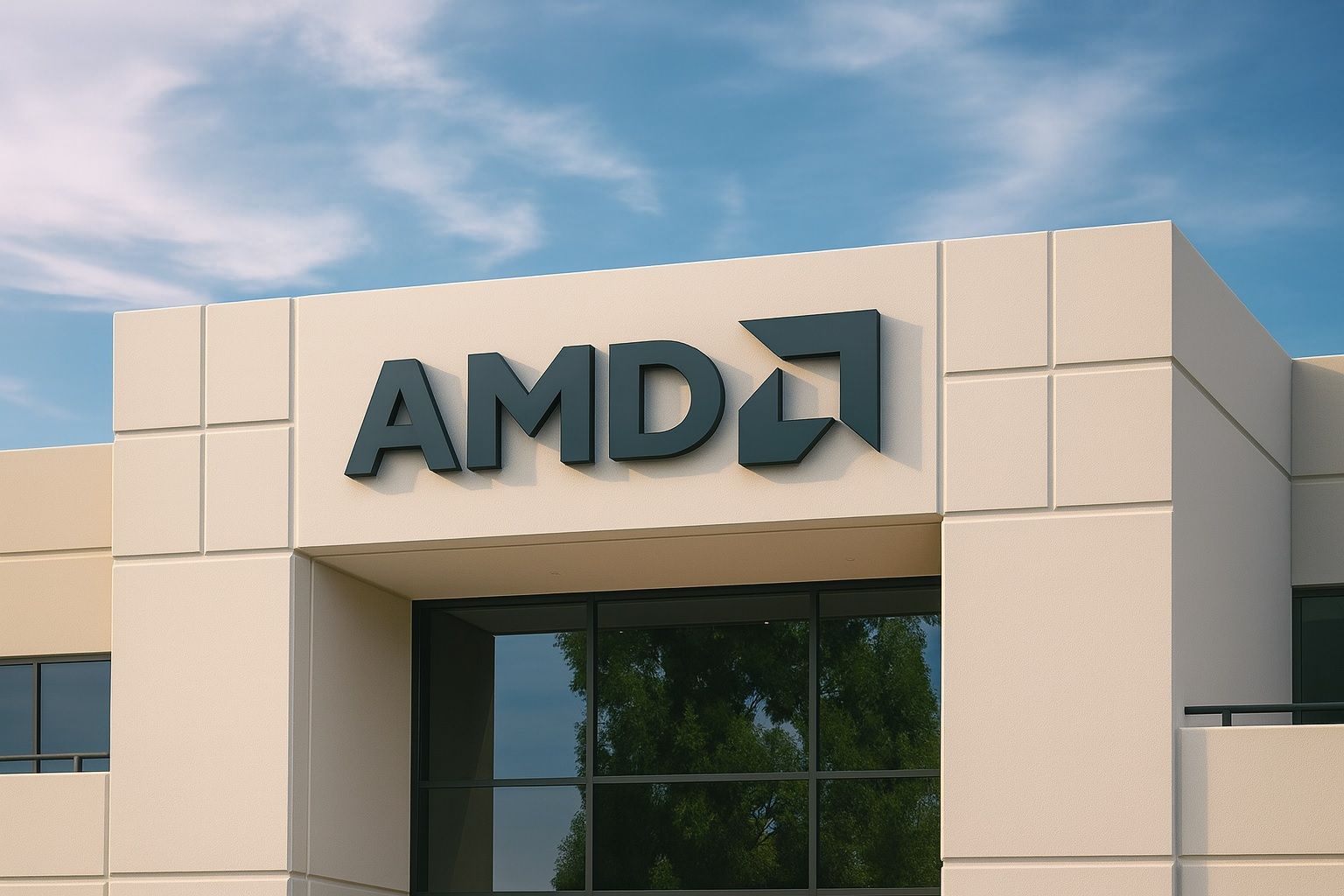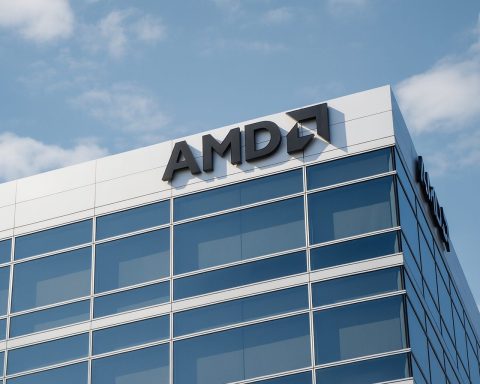- Price: AMD closed at $214.90 on Friday Oct 10, 2025 [1] and was trading around $224 pre-market on Oct 13 [2]. Year-to-date, AMD is up roughly 70–90% (far outpacing peers – e.g. ~40% for Nvidia [3]). Its market capitalization is now on the order of $320–330 billion [4], making it the world’s third-largest chipmaker (behind Nvidia and TSMC).
- Major News: On Oct 6, 2025, AMD announced a blockbuster multi-year deal to supply 6 gigawatts of AI chips to OpenAI [5] [6]. This deal includes warrants for OpenAI to buy ~10% of AMD at $0.01/share (vesting up to a $600 target [7] [8]). The agreement could deliver “tens of billions of dollars” in revenue [9] [10] and has been called “certainly transformative…for the industry” [11] [12]. The stock jumped ~30–34% on the news, its largest one-day gain in nearly a decade [13] [14].
- Analysts: Wall Street is broadly bullish. Many firms have raised price targets after the OpenAI news – for example, Jefferies upgraded AMD to Buy with a $300 target [15], UBS to $210 [16], and HSBC to $200 [17]. About 60–65% of analysts rate AMD a Buy (roughly 28 of 44) [18]. That said, some experts warn the stock now trades at a rich valuation (~90× forward earnings), leaving “little room for error” [19] [20].
- Technicals: The chart shows a breakout of a long-term bullish pattern. Investopedia notes AMD surged to a 19-month high on the news, completing an inverse head-and-shoulders breakout [21]. Key resistance zones lie near $227 (Monday’s intraday high) and $272 (pattern target) [22], with supports around $174 and $150 on pullbacks [23]. Momentum indicators are overbought short-term [24], so a consolidation or pullback is possible.
- Fundamentals: AMD’s recent results have been strong. Q2 2025 revenue hit $7.7 billion (+32% YoY) [25], driven by server CPUs and initial AI chip sales. The company guided ~$8.7 billion for Q3 [26], implying ~33 billion for FY2025 (versus $23.6B in 2024) [27]. Margins dipped (~43%) due to heavy R&D and inventory build for new chips [28]. U.S. export curbs to China are estimated to shave $1.5 billion off AMD’s revenue this year [29] [30]. Overall, the fundamentals are growth-oriented but carry some near-term headwinds (inventory and geopolitics).
- Sector Trends: AMD’s boom is part of a broader AI-driven semiconductor rally [31] [32]. Global demand for AI chips is surging (analysts project ~30%+ annual growth in AI compute through 2030s [33]). TSMC, AMD’s chip foundry partner, has hit record highs (briefly a $1 trillion market cap) as it ramps new nodes for NVIDIA, AMD, OpenAI etc. [34]. However, investors are also watching rising tensions – U.S.–China trade frictions sent markets down on Oct 10 [35], and China’s rare-earth and export controls add uncertainty.
Recent Stock Performance
In the week leading to Oct 13, AMD’s stock was extremely volatile. It soared on Oct 6 after the OpenAI announcement: shares jumped over 30% intraday, their biggest one-day gain since 2016 [36] [37]. By midweek, it hit a 52-week intraday high around $235–$240 [38] [39]. After peaking, the stock pulled back modestly. By Friday Oct 10 it closed at $214.90 [40], off about 8% from the midweek highs, as tech stocks broadly sold off on renewed trade-war fears [41] [42]. For perspective, AMD is still up roughly 75–80% YTD [43] (versus ~40% for Nvidia over the same period) [44]. The pullback on Oct 10 was partly due to President Trump’s tariff threats, which knocked down major tech stocks (Nvidia, Amazon, AMD all fell after the bell) [45]. Overall, the trend has been strongly upward: since late September (~$160), the stock has roughly +30% in a few days [46] [47].
Major News & Company Developments
OpenAI Partnership: The defining news was AMD’s multi-year AI chip deal with OpenAI, announced Oct 6 [48]. Under this agreement, AMD will supply hundreds of thousands of its high-end MI450/MI300X GPUs (totaling ~6 gigawatts of compute) to OpenAI over several years [49] [50]. AMD estimates this could generate “tens of billions” in annual revenue once in full production [51] [52]. Crucially, AMD granted OpenAI warrants to acquire up to ~160 million shares (~10% of AMD) at $0.01/share, vesting on delivery milestones and stock-price targets (up to a $600 AMD share price) [53] [54]. AMD’s data-center chief Forrest Norrod (via Reuters) called the deal “certainly transformative…for the industry” [55] [56], and CEO Lisa Su echoed that view in media interviews [57] [58]. This was one of the largest moves toward diversifying AI chip suppliers away from NVIDIA, capturing investor excitement.
Product & Strategy: AMD has also been rolling out new chips and initiatives. Its latest data-center GPU, the MI300X (used in the OpenAI deal), is shipping now, and AMD has announced a successor MI400 series (Instinct accelerators) for 2026 [59]. Additionally, AMD unveiled an open “Helios” supercomputer design with industry-standard interconnects (Ethernet, x86) to attract cloud builders wary of proprietary lock-in [60]. Several hyperscale customers (Microsoft, Meta, Oracle, etc.) are already testing or deploying AMD’s MI300X processors for AI workloads [61]. On the CPU side, AMD’s Ryzen and EPYC lines continue to chip away at Intel’s market share [62]. Notably, reports say Intel (long AMD’s rival) is even in talks to manufacture chips for AMD on its new foundry platform [63] – a sign of strong overall chip demand forcing unlikely “coopetition” in the industry [64].
Other News: There were no other blockbuster AMD stories in the past few days beyond the AI deal. However, the company did note on its recent earnings call that U.S. export controls (requiring licenses for some AI chips to China) could hurt revenue (about $1.5B lost this year) [65] [66]. AMD is awaiting clearance to ship its MI308 chips to China once licenses are approved. Finally, AMD’s investor events and interviews have emphasized the long-term “AI supercycle” opportunity [67].
Technical Analysis
Technically, AMD’s chart is in a steep uptrend. On Oct 6–8 the stock formed a classic inverse head-and-shoulders breakout – Monday’s open-of-gap constituted the right shoulder, breaking decisively above ~$175 [68]. This breakout has set bullish targets; technical analysts note that reaching the top of the pattern implies a price around $270–$272 [69], well above current levels. Near-term, key resistance is the mid-October high near $227 [70] (Monday’s intraday peak), which it will need to hold for continued momentum. Support appears around the $174–$180 zone (Monday’s gap fill area) and the prior shoulder at $150–$160 [71]. Momentum indicators (e.g. RSI) are signaling short-term overbought conditions [72], so some consolidation or a pullback is likely before the next leg up. Overall, chart patterns favor the bulls in this AI-driven run, but traders should watch those support levels in case of a retracement.
Fundamental Analysis
On the fundamentals, AMD is enjoying strong growth, though it faces margin pressure. For Q2 2025 (reported in late July), AMD posted record revenue of about $7.7 billion (a 32% increase from a year ago) [73]. Profit (GAAP net income) was $872 million on ~$7.69B sales [74]. The data-center segment (CPUs plus Instinct GPUs) grew roughly 14% to $3.2B [75], which was a bit below the explosive growth seen by Nvidia (up 73% in its AI segment). AMD CEO Lisa Su explained that data-center AI revenue was hurt by U.S. export curbs to China and by an inventory transition to the new MI350 chips [76]. AMD still expects a sharp ramp in MI350 production in H2 2025 [77].
Management guided for ~$8.7B in Q3 revenue [78] (about +20% YoY) with gross margins roughly in the mid-50s (54% target) [79]. Full-year 2025 consensus is around $32–33 billion in sales (versus $23.6B in 2024) [80]. However, much of next year’s upside depends on new AI-related orders (e.g. OpenAI shipments in 2026) and recovering gross margins. Margins slid to ~43% in Q2 due to heavy R&D spend and an $800M inventory charge for AI chips [81]. Analysts note AMD is plowing cash into fabs and packaging (including Fan-Out Wafer-Level Packaging factories) and aggressive R&D to catch up in AI accelerators.
Valuation is rich: after the recent rally, AMD trades around 90× forward earnings [82]. That multiple reflects sky-high growth expectations. If revenue and profits continue to beat forecasts, the premium may hold. But any slowdown (e.g. delayed chip rollouts, or softer demand) could quickly deflate it. AMD’s balance sheet is strong (net cash) and it has no large debt, which gives flexibility, but shareholders should watch how aggressively it burns cash on R&D/capex. In summary, the fundamentals support a strong growth story (20–30%+ revenue growth, centric to AI), but earnings are still modest in absolute terms, making the valuation outlook-sensitive.
Analysts & Market Sentiment
Wall Street analysts have generally upgraded AMD in light of the AI news. For example, Jefferies’ Street-high $300 target [83] reflects confidence in AMD’s AI roadmap. Other brokerages like Northland, Rosenblatt, etc. have lifted targets into the $190–$250 range [84]. HSBC and UBS likewise raised their outlooks, seeing the OpenAI deal as a game-changer. As a group, about 28 of 44 analysts rate AMD a Buy or Strong Buy [85]. Even conservative firms have moved off the sidelines: Goldman Sachs, which held a ~$140 target earlier, publicly warned that the AI optimism was “overvalued” and kept that lower target [86].
Investor commentary has been very bullish. CNBC’s Jim Cramer lauded the deal on air: he said it “verif[ies] the total addressable market” for AMD’s AI chips and praised CEO Lisa Su for persevering (“AMD…won’t quit…She never quit.”) [87]. Mutual fund managers like Leah Bennett (of Concurrent Asset Management) view the OpenAI pact as “a major vote of confidence” in AMD’s tech [88]. Dan Coatsworth (A.J. Bell) noted that with OpenAI taking a stake, it will help drive AMD’s strategy forward [89]. On the flip side, some portfolio managers advise caution: Dan Morgan of Synovus Trust (a shareholder of both AMD and Nvidia) commented that AMD’s latest data-center growth was “enough to raise an eyebrow” [90], implying expectations may need moderation. In brief, institutional sentiment is strongly positive but not unanimous – the consensus is now bullish, but there are skeptical voices worried about high expectations.
Among retail investors and traders, sentiment is ebullient. Social media forums (Reddit’s r/AMD, StockTwits, etc.) are full of bullish chatter about the AI deal, with many calling AMD the next “AI king.” While these do not serve as formal analysis, they reflect widespread excitement. Some retail traders note the dilution risk from the OpenAI warrants (as one forum quipped, AMD basically gave OpenAI a bargain-priced stake), but most are riding the momentum. The key point is that retail sentiment is one-sidedly optimistic right now, mirroring the broader tech euphoria. This optimism can add fuel to short-term moves, but it also means the stock is vulnerable if any unexpected bad news hits (since hype is high).
Competitive Positioning
AMD sits as the third biggest player in semiconductors by market value [91]. Its main rivals are Nvidia and Intel (along with giant foundry TSMC, though TSMC is AMD’s partner on manufacturing). In the AI accelerator market, Nvidia remains dominant. Recent data put Nvidia’s share of AI/GPU chips at about 94% [92]. AMD’s GPUs (Instinct MI-series) have historically trailed Nvidia in performance and ecosystem (CUDA), but AMD has improved its chip designs and is pushing an open-software strategy (ROCm) to win customers wanting an alternative. Landing OpenAI is huge because it validates AMD as a credible #2 provider. If AMD can convert more hyperscaler customers, it can gradually gain share, but overtaking Nvidia’s lead is a tall order.
Against Intel, AMD has been winning CPU market share for years. Today AMD claims over 25% of the server CPU market and a majority share in high-end PC CPUs [93]. Intel’s turnaround (with U.S. government backing and new leadership) is underway, but AMD’s EPYC chips have given it a real platform. The surprising news that Intel’s foundry might help make AMD chips [94] underscores AMD’s lack of fabrication capacity (it relies almost entirely on TSMC). In consumer graphics (gaming consoles, PCs), AMD and Nvidia remain close competitors, though Nvidia leads high-end gaming GPUs. AMD does hold the console market (its chips power the latest PlayStation and Xbox), which provides steady revenue outside the PC/AI cycles.
Other chipmakers (Qualcomm, Broadcom, etc.) touch different segments (mobiles, networking) and are less direct rivals in AMD’s core markets. AMD’s strategy is clear: be the “open” alternative in data centers (leveraging x86 CPUs plus accelerators) while continuing its CPU and gaming businesses. Its competitive edge versus Nvidia is pricing and openness; versus Intel, it’s high performance-per-watt and ecosystem momentum. In any case, AMD’s rapid ascent has forced competitors to cooperate (Intel foundry talks) or double-down (Nvidia’s $100B OpenAI investment) – a testament to AMD’s disruptive positioning.
Semiconductor & AI Industry Trends
AMD’s fortunes are tightly linked to broader AI and semiconductor cycles. We are in what many call an AI “supercycle.” Global spending on data centers and AI infrastructure has exploded in 2023–2025. This mega-trend is evident in chipmakers’ results: TSMC’s revenues jumped ~30–44% YoY in 2025 [95] and its stock hit record highs (surpassing $300 per ADS) [96]. As TS2 Tech notes, “TSMC is essentially the ‘arms dealer’ of the AI boom…fabricating silicon for NVIDIA, AMD, Apple, OpenAI, and others” [97]. High-performance computing chips now make up ~60% of TSMC’s revenues [98], underscoring how much of the market is AI-related.
Geopolitics also loom large. U.S.–China tensions have introduced noise: President Trump’s tariff threats (e.g. a proposed 100% tariff) spooked markets [99]. China simultaneously tightened rare-earth exports (crucial for chip magnets) [100]. These moves briefly toppled tech stocks on Oct 10 [101]. On the chip export front, U.S. curbs (under the CHIPS Act and Commerce regulations) mean AMD needs licenses to sell some of its latest chips (MI308) to China [102]. AMD said it expects about a $1.5B annual hit from these curbs [103] [104].
On the positive side, government support in the U.S. (CHIPS Act subsidies) and Europe (digital sovereignty initiatives) are pouring money into fabs. This should help the industry grow capacity (benefiting foundries like TSMC/GlobalFoundries) and ultimately AMD’s access to production. Meanwhile, capital spending is surging at big AI end-users: Microsoft, Meta, Google all announced multibillion-dollar cloud capex budgets to expand AI infrastructure, which should increase demand for AMD’s and Nvidia’s chips.
Finally, investor sentiment is heavily colored by the AI theme. Many now see tech valuations as “frothy” like the late 1990s dot-com boom [105]. “Everything is priced for perfection,” warns some strategists [106]. But others say even if a short-term pullback comes from macro jitters, the long-term AI demand story remains intact [107]. This mixed backdrop – enormous opportunity tempered by high risk – means AMD’s trajectory will be influenced as much by industry trends as by company execution.
Market Forecast: Short-, Medium-, and Long-Term Outlook
- Short Term (weeks): After the massive rally, expect volatility and consolidation. Technically, AMD is overbought, so profit-taking or a pause is likely [108]. Watch the support around $180–190 (broken gap area) and the $214 pivot. If markets dip (e.g. on macro news), AMD could fall toward $180–200; if AI optimism persists, a bounce back toward recent highs ($227+) is possible. Next catalysts will be any updates from the OpenAI project or earnings (Q3 results likely in early Nov).
- Medium Term (months, ~6–12 months): Assuming execution stays on track, AMD’s stock could extend its rally. In this window, shipments of the first MI450 chips (starting OpenAI’s 1GW build-out in H2 2026) [109] and continued adoption of MI300X by cloud customers should start contributing to revenue. Analysts currently look for ~$32–33B revenue in 2025 [110] and similar growth in 2026. Price targets in the $250–300 range (Jefferies’ $300 being the high end [111]) assume AMD meets those expectations. If AI-driven demand stays strong, AMD could reach new highs by late 2025. However, medium-term risks include execution hiccups, worsening trade tensions, or a rotation out of tech stocks.
- Long Term (2–5 years): Over several years, AMD’s fate is tied to the AI supercycle’s scale. If industries indeed shift massively toward AI (OpenAI’s Sam Altman has spoken of needing 250 GW of compute by 2033 [112]), then demand for data-center chips could explode. AMD’s strategy of open architectures and partnerships positions it to capture a share of this. By 2028–2030, AMD might close the gap with NVIDIA in specialized accelerators (especially for inference tasks where Nvidia’s CUDA advantage is less). On the other hand, Nvidia’s dominance (and its own innovations) remains formidable – AMD will likely remain a “#2” player in AI hardware [113]. Long-term bear risks include a reset in AI hype (slower technology adoption), disruptive competition (e.g. new architectures), or macro downturns. Still, at present, AMD is widely seen as a key beneficiary of the multi-trillion-dollar AI opportunity ahead.
Sources: Analysis is based on financial news and data (including Reuters, TS2 TechStock², Investopedia, company filings, and market reports) [114] [115] [116] [117] [118] [119] [120] [121] [122] [123], with all figures and quotes cited above.
References
1. www.investing.com, 2. www.investing.com, 3. www.investopedia.com, 4. ts2.tech, 5. ts2.tech, 6. www.reuters.com, 7. ts2.tech, 8. www.reuters.com, 9. ts2.tech, 10. timesofindia.indiatimes.com, 11. www.reuters.com, 12. timesofindia.indiatimes.com, 13. ts2.tech, 14. www.reuters.com, 15. ts2.tech, 16. ts2.tech, 17. ts2.tech, 18. ts2.tech, 19. ts2.tech, 20. ts2.tech, 21. www.investopedia.com, 22. www.investopedia.com, 23. www.investopedia.com, 24. www.investopedia.com, 25. ts2.tech, 26. ts2.tech, 27. ts2.tech, 28. ts2.tech, 29. www.reuters.com, 30. www.reuters.com, 31. www.reuters.com, 32. ts2.tech, 33. ts2.tech, 34. ts2.tech, 35. www.reuters.com, 36. ts2.tech, 37. www.reuters.com, 38. ts2.tech, 39. www.investopedia.com, 40. www.investing.com, 41. www.reuters.com, 42. www.investing.com, 43. www.investopedia.com, 44. www.investopedia.com, 45. www.reuters.com, 46. www.investing.com, 47. www.investopedia.com, 48. ts2.tech, 49. ts2.tech, 50. www.reuters.com, 51. ts2.tech, 52. timesofindia.indiatimes.com, 53. ts2.tech, 54. www.reuters.com, 55. www.reuters.com, 56. timesofindia.indiatimes.com, 57. timesofindia.indiatimes.com, 58. timesofindia.indiatimes.com, 59. ts2.tech, 60. ts2.tech, 61. ts2.tech, 62. ts2.tech, 63. ts2.tech, 64. ts2.tech, 65. www.reuters.com, 66. www.reuters.com, 67. timesofindia.indiatimes.com, 68. www.investopedia.com, 69. www.investopedia.com, 70. www.investopedia.com, 71. www.investopedia.com, 72. www.investopedia.com, 73. ts2.tech, 74. www.reuters.com, 75. www.reuters.com, 76. www.reuters.com, 77. www.reuters.com, 78. ts2.tech, 79. www.reuters.com, 80. ts2.tech, 81. ts2.tech, 82. ts2.tech, 83. ts2.tech, 84. ts2.tech, 85. ts2.tech, 86. ts2.tech, 87. www.insidermonkey.com, 88. www.reuters.com, 89. www.reuters.com, 90. www.reuters.com, 91. ts2.tech, 92. ts2.tech, 93. ts2.tech, 94. ts2.tech, 95. ts2.tech, 96. ts2.tech, 97. ts2.tech, 98. ts2.tech, 99. www.reuters.com, 100. www.reuters.com, 101. www.reuters.com, 102. www.reuters.com, 103. www.reuters.com, 104. www.reuters.com, 105. www.reuters.com, 106. www.reuters.com, 107. www.reuters.com, 108. www.investopedia.com, 109. www.nasdaq.com, 110. ts2.tech, 111. ts2.tech, 112. www.reuters.com, 113. ts2.tech, 114. ts2.tech, 115. ts2.tech, 116. www.reuters.com, 117. www.investopedia.com, 118. www.reuters.com, 119. www.reuters.com, 120. ts2.tech, 121. www.nasdaq.com, 122. timesofindia.indiatimes.com, 123. www.insidermonkey.com







